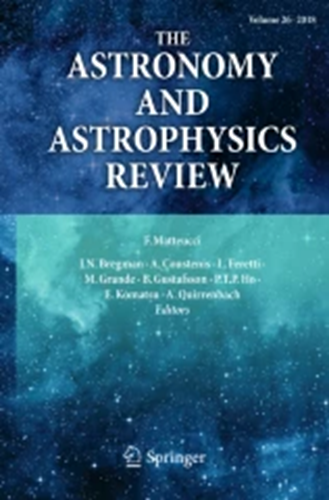洛克曼洞场中残余射电星系的多频特征
IF 26.5
1区 物理与天体物理
Q1 ASTRONOMY & ASTROPHYSICS
引用次数: 7
摘要
残余射电星系代表了射电活动星系核生命周期的一个重要阶段。有人认为,在这个阶段,喷流已经关闭,扩展的发射正在迅速消退。由于缺乏在低频率和高频率观察到的统计样本,这一阶段没有得到很好的研究。在这项工作中,我们研究了先前在洛克曼洞场使用150 MHz低频阵列选择的23个候选残余射电星系样本。我们研究了它们的形态和光谱特性,以确定它们的残余性质,并修改了用于定义初始样品的形态和光谱标准。本文介绍了卡尔·g·扬斯基甚大阵列在6000兆赫高分辨率和低分辨率下的新观测结果。这些观测使我们能够观察到核心的存在或不存在,并研究残余候选者在这些高频率下预计的总发射光谱的光谱曲率和陡峭度。我们确认23个候选者中有13个是残余射电源。这相当于Lockman Hole油田全部活跃、重新启动和剩余候选样本的7%。令人惊讶的是,只有少数残余物存在于星团中(23%)。残余的射电星系显示出一系列的特性和形态。大多数在6000兆赫没有显示出核心的检测,并且它们的扩展发射通常显示出超陡光谱(USS)。然而,也有美国总发射的残余物和探测到的核心在6000兆赫兹,可能表明残余物阶段的各种进化阶段。我们确认了形态和光谱标准结合的重要性,这需要在选择残余射电源样本时加以考虑。本文章由计算机程序翻译,如有差异,请以英文原文为准。
Multi-frequency characterisation of remnant radio galaxies in the Lockman Hole field
Remnant radio galaxies represent an important phase in the life-cycle of radio active galactic nuclei. It is suggested that in this phase, the jets have switched off and the extended emission is fading rapidly. This phase is not well-studied due to the lack of statistical samples observed at both low and high frequencies. In this work, we study a sample of 23 candidate remnant radio galaxies previously selected using the Low Frequency Array at 150 MHz in the Lockman Hole field. We examine their morphologies and study their spectral properties to confirm their remnant nature and revise the morphological and spectral criteria used to define the initial sample. We present new observations with the Karl G. Jansky Very Large Array at 6000 MHz at both high and low resolution. These observations allowed us to observe the presence or absence of cores and study the spectral curvature and steepness of the spectra of the total emission expected at these high frequencies for the remnant candidates. We confirm 13 out of 23 candidates as remnant radio sources. This corresponds to 7% of the full sample of active, restarted, and remnant candidates from the Lockman Hole field. Surprisingly, only a minority of remnants reside in a cluster (23%). The remnant radio galaxies show a range of properties and morphologies. The majority do not show detection of the core at 6000 MHz and their extended emission often shows ultra-steep spectra (USS). However, there are also remnants with USS total emission and a detection of the core at 6000 MHz, possibly indicating a variety of evolutionary stages in the remnant phase. We confirm the importance of the combination of morphological and spectral criteria and this needs to be taken into consideration when selecting a sample of remnant radio sources.
求助全文
通过发布文献求助,成功后即可免费获取论文全文。
去求助
来源期刊

The Astronomy and Astrophysics Review
地学天文-天文与天体物理
CiteScore
45.00
自引率
0.80%
发文量
7
期刊介绍:
The Astronomy and Astrophysics Review is a journal that covers all areas of astronomy and astrophysics. It includes subjects related to other fields such as laboratory or particle physics, cosmic ray physics, studies in the solar system, astrobiology, instrumentation, and computational and statistical methods with specific astronomical applications. The frequency of review articles depends on the level of activity in different areas. The journal focuses on publishing review articles that are scientifically rigorous and easily comprehensible. These articles serve as a valuable resource for scientists, students, researchers, and lecturers who want to explore new or unfamiliar fields. The journal is abstracted and indexed in various databases including the Astrophysics Data System (ADS), BFI List, CNKI, CNPIEC, Current Contents/Physical, Chemical and Earth Sciences, Dimensions, EBSCO Academic Search, EI Compendex, Japanese Science and Technology, and more.
 求助内容:
求助内容: 应助结果提醒方式:
应助结果提醒方式:


